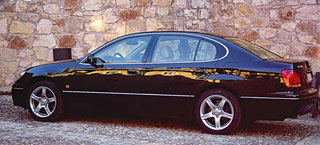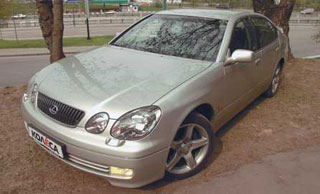Test drive Lexus GS 2000 - 2005 sedan
Brothers Lexus
Toyota has been entrenched in the North American market for a long time and firmly. Her cars never stood out by designer sorts, but were distinguished by reliability and quality - at a relatively low cost. The current image over time began to interfere with companies that wanted to penetrate the prestigious cars. A new brand was required, which would not be associated with Toyota models. So Lexus appeared.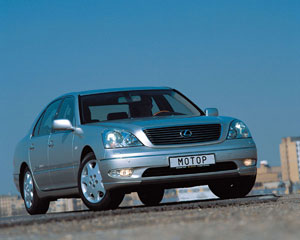 The example of Toyota was followed by other Japanese manufacturers - Honda (Acura), Nissan (Infiniti), but the Lexus brand is still better than others. The company's success in the luxury sector of the American market laid the LS 400 sedan debut in 1990, which offered no less comfort than the main competitors from Germany and Great Britain, but at a lower price. The public liked the car. And went and went ...
The example of Toyota was followed by other Japanese manufacturers - Honda (Acura), Nissan (Infiniti), but the Lexus brand is still better than others. The company's success in the luxury sector of the American market laid the LS 400 sedan debut in 1990, which offered no less comfort than the main competitors from Germany and Great Britain, but at a lower price. The public liked the car. And went and went ... Recently, the Lexus brand has been officially present on the Russian market - in April, the first show room was opened in Moscow, where part of the Lexus model range is represented. We took two sedans for the test - LS 430 and GS 430. Almost the same chassis, identical power units. The company supplies the first car as luxury, the second - as sports. Moreover, the difference in price is about $ 20,000. A lot ...
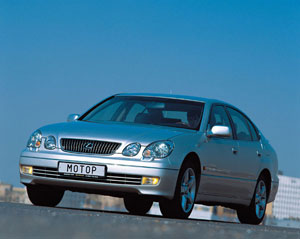 Lexus LS is the third generation of a car updated last year. It looks solid, representative and expensive: a massive sidewall, a large rear overhang, huge transparent caps of the front headlights, which slightly revive the boring look. The only trouble is that the car looks strongly on the Mercedes S-Class of the penultimate generation. Or maybe it doesn’t matter ...
Lexus LS is the third generation of a car updated last year. It looks solid, representative and expensive: a massive sidewall, a large rear overhang, huge transparent caps of the front headlights, which slightly revive the boring look. The only trouble is that the car looks strongly on the Mercedes S-Class of the penultimate generation. Or maybe it doesn’t matter ... The GS sedan appeared on the market in 1997. Now the second generation of the car is already on the conveyor. GS looks more terrible than LS, and also not in Japanese. The active side line, a falling hood crowned with four headlights, a wide bumper smile ... There is a small plastic spoiler on the trunk cover - rather a tribute to the image than a necessity. And again, the similarity with Mercedes, this time E-class, is visible.
Despite the differences in appearance, both cars have pronounced family features, and if you put them nearby, there is generally a feeling that they are brothers. The same color of the bodies only enhances this impression ...
The Lexus LS 430 salon is a sample of conservative luxury. Designers studied not only competitors' cars, but also the best chic hotels, the salons of expensive private aircraft, the work of watchmakers and jewelers ... They even spent some time in the workshop of the famous guitar master - they learned to handle wood. With the latter, perhaps, they went too far - wooden panels and lining of the steering wheel Lexus LS shine with such a strong brilliance that they seem to be imitation. The musical department of Yamaha is engaged in a tree for LS ...
The interior decoration, of course, is leather. The driver's seat is soft and deep - you sit like in a good home chair. Electric settings, with memory. There are 14 of them at the driver's seat, the passenger - 10. (In memory, the settings of not only the chairs, but also the steering column and rear -view mirrors are laid.) The rollers of lateral support are present, but, as it turned out later, their functions do not quite do - too soft. There is both heating and ventilation of the seats, and chilled air from the air conditioner can be supplied to the ventilation system.
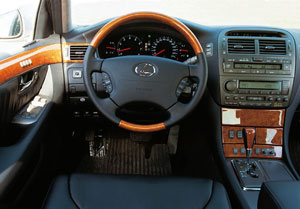 The instrument shield is a large black spot. Only after turning on the ignition, two large and two small dials with white numbers in the black field become visible. They look spectacular, read perfectly.
The instrument shield is a large black spot. Only after turning on the ignition, two large and two small dials with white numbers in the black field become visible. They look spectacular, read perfectly. The Lexus LS 430 automatic climatic installation has separate adjustments for all passengers and the driver, in addition, if the sun heats one or another side of the car, the installation itself correctly adjusts the supply of cold air.
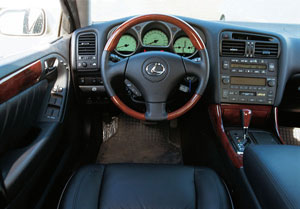 The salon is voiced by the company cassette radio radio (tuner - with RDS), a six discs for six discs, eight speakers and a subwoofer. Music control is carried out by buttons on the steering wheel.
The salon is voiced by the company cassette radio radio (tuner - with RDS), a six discs for six discs, eight speakers and a subwoofer. Music control is carried out by buttons on the steering wheel. The volume of the salon (and trunk) is larger than that of Mercedes S -class. Especially free from behind, there are plenty of space in all directions. Moreover, the rear seat is clearly designed for two. The halves are separated from each other in a folding armrest in which there is a duplicate audio control unit and buttons, heads of individual seats. A small compartment is hidden behind the armrest cooled by air conditioning - this would definitely determine the landing place of the owner of the car, if not for the same mini -bar in the front armrest ...
Having climbed into the GS 430, you immediately realize that you got into an expensive car that is not alien to a sports spirit. The main hint of this is the scales of devices in three deep niches-collars with aluminum rims, illuminated by some kind of unearthly light.
The design of the salon is similar, and the tree is even more than in LS. True, the real tree in GS is only on the steering wheel, the rest is a successful imitation. The steering wheel has a greater section than in LS, and in the grip is more convenient.
The skin, electrical adjustments of the seats and the steering column with memory, an automatic air conditioner ... Everything seems to be the same, but a little easier. Dynamics, for example, not eight, but six. There is no remote control in the second row, ventilation of seats, automatic door closers and much more. Not so spacious interior - the machine is 200 mm shorter and 30 mm already, and the wheelbase is 125 mm smaller. But the space behind is quite enough for the legs, and above the head, and in the shoulders - the seat is also designed for two. As in LS, it is divided in half by a folding armrest, and a high tunnel of the cardan shaft passes below.
The lateral support of the driver's seat is more expressed than in LS, but for a sports car is still insufficient.
The common aura of the salon is quite European, but softer and welcoming than, for example, Audi or BMW ...
Often you can hear the statements that Lexus cars are too sterile, and, unlike European models, excessively care about the driver, practically isolation from the road - this, they say, interferes with active driving. But what sterility can we talk about if under the hoods of both machines motors with a capacity of 300 hp, and the drive on the rear wheels? Let's try to check ...
The Lexus LS 430 was perhaps the quietest car of all that I had to deal with - to understand whether the engine started, it was necessary to look at the tachometer.
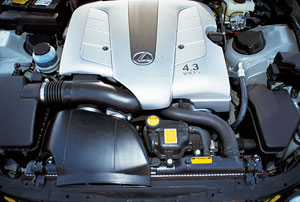 A powerful, confident, smooth speed set. The V-shaped eight of 4.3 liters silently and without visible efforts accelerates the car to a hundred in just 6.7 seconds. (Mercedes S430 takes 7.3 seconds.). The automatic adaptive box sorts the transmission completely imperceptibly. The speedometer is digitized to 280, but the real speed is artificially limited to 250 km/h.
A powerful, confident, smooth speed set. The V-shaped eight of 4.3 liters silently and without visible efforts accelerates the car to a hundred in just 6.7 seconds. (Mercedes S430 takes 7.3 seconds.). The automatic adaptive box sorts the transmission completely imperceptibly. The speedometer is digitized to 280, but the real speed is artificially limited to 250 km/h. On a good coating, the car flies like an air cushion. No aerodynamic noise - not without reason the LS body was blown in the same aerodynamic pipe where Sinkansen's high -speed Japanese trains experience. It was thought that about the isolation of critics, perhaps, were right: neither tremors, nor vibrations, nor noise. In addition, an empty steering wheel. Even when moving in a straight line instinctively, you twitch it, trying to understand if he has a connection with the wheels. But on poor coverage, the situation changes - seams and potholes are felt quite clearly. Perhaps, with a self-leveling pneumatic suspension, it would be different, but cars with it are not supplied to Russia.
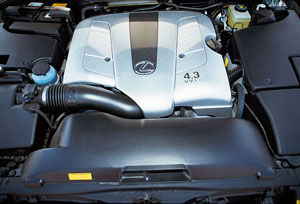 Despite the weak feedback on the steering wheel, the controllability of the Lexus LS 430 is worthy of praise. In normal modes, the car is very obedient and accurately reacts to the driver’s instructions, holds the trajectory in corners well. The rolls are small. That's just the steering wheel has to twist quite quickly - its range is as many as 3.5 turns. However, for a car of this class, this should not be considered a disadvantage ...
Despite the weak feedback on the steering wheel, the controllability of the Lexus LS 430 is worthy of praise. In normal modes, the car is very obedient and accurately reacts to the driver’s instructions, holds the trajectory in corners well. The rolls are small. That's just the steering wheel has to twist quite quickly - its range is as many as 3.5 turns. However, for a car of this class, this should not be considered a disadvantage ... On a good road, the Lexus GS 430 behaves no worse. The same impressive set of speed, the same delicate operation of an automatic box. The GS 430 has the same as the LS 430, the power unit, but the car weighs 150 kg less, so acceleration to hundreds is several tenths of a second faster. A more informative steering wheel, tougher suspension, less rolls in corners. Everything is about the same as LS, if the adjustment of its suspensions is transferred to a sports regime (LS has such an opportunity, but GS does not). Even on small irregularities, the car is significantly shaking.
The same (almost) silence in the cabin. Almost - because the sound of the exhaust is slightly heard in the GS, quite convincing and pleasant. It seems that they released him intentionally. The company insists: Lexus GS is not just a luxury car that was clamped by the suspension and put more tires, this is a car -sports car.
Since the Lexus GS 430 is served as a sports sedan, it was simply necessary to skate in the limit modes on the racing highway. And if so - we attach to it and the luxury LS. First, we will try to enable the contrasting system VSC (Vehicle Stability Control). In this mode, both machines demonstrate a clearly expressed insufficient rotation - they are pulled out of turn, and the stabilization system, slowing down the necessary wheels, tries to correct the situation. And, it should be noted, quite successfully.
Ceteris paribus, the speed of turning on GS was higher. But there is a feeling that this is a merit not so much of the suspension settings as the tires - wider and lowest.
Brake systems for both machines work like without complaints, except that ABS intervenes a little earlier than we would like ...
 If you turn off the stabilization system, the behavior of cars changes radically. When passing the turn under the traction, both try to tear the rear axle into the skid. The breakdown occurs on LS faster and almost without warning (possibly due to higher and narrow rubber). You can cope with the skid, while the corners are small, and even then only by search steering - the reactive effect on the steering wheel is not enough, and further actions resemble the game on the computer simulator. Lexus GS in this regard is better - it is not so willing to break into the skid. But it is better not to turn off the VSC stabilization system on it ...
If you turn off the stabilization system, the behavior of cars changes radically. When passing the turn under the traction, both try to tear the rear axle into the skid. The breakdown occurs on LS faster and almost without warning (possibly due to higher and narrow rubber). You can cope with the skid, while the corners are small, and even then only by search steering - the reactive effect on the steering wheel is not enough, and further actions resemble the game on the computer simulator. Lexus GS in this regard is better - it is not so willing to break into the skid. But it is better not to turn off the VSC stabilization system on it ... In a word, brothers. But far from twins. Lexus LS 430 - the embodiment of the concept of luxury in its classical sense. As in a good hotel - service is excellent, and at the same time everything is unnoticed, unobtrusive. Lexus GS 430 is an outstanding sports-class sports class. Direct competitors of these cars are BMW 740 and 540, Mercedes S430, Infiniti Q45, Audi A8 and A6, Jaguar XJ8.
The rivals are worthy. And even if in the eyes of many buyers, the stylized L on the radiator grill does not look as convincing as the white -blue propeller or the three -beam star - the situation is changing, and quickly. Today, among the Russian bourgeois, it is no longer too customary to throw money, spending it reasonably not shameful. Lexus cars - for them ...
The first LS 400 in 1990 cost about $ 35,000 in the United States, four hundred and twentieth Mercedes - about $ 60,000. The exchange rate to the dollar that changed since then has significantly reduced the price gap, and the German competitors did not lose time. Now the official Russian dealers Lexus LS 430 costs about $ 90,000 (GS 430 - $ 70,000). The equipment is all inclusive, from the options - only the hatch in the roof. Mercedes S430 in a similar configuration in an official dealer will cost at least $ 100,000.
And here is another observation. Many cars of the Japanese Toyota brand are actually assembled in the USA (some only there). However, all the cars of the American Lexus brand are collected only in Japan (Lexus LS is known there as Toyota Celsior, and Lexus GS as Toyota Aristo). And it turns out that on the side of Lexus is also an unsurpassed Japanese quality. Ratings J.D. Power and Associates can be believed.
Text: Alexander Naydenov
A source: Motor magazine [No. 6/2002]







